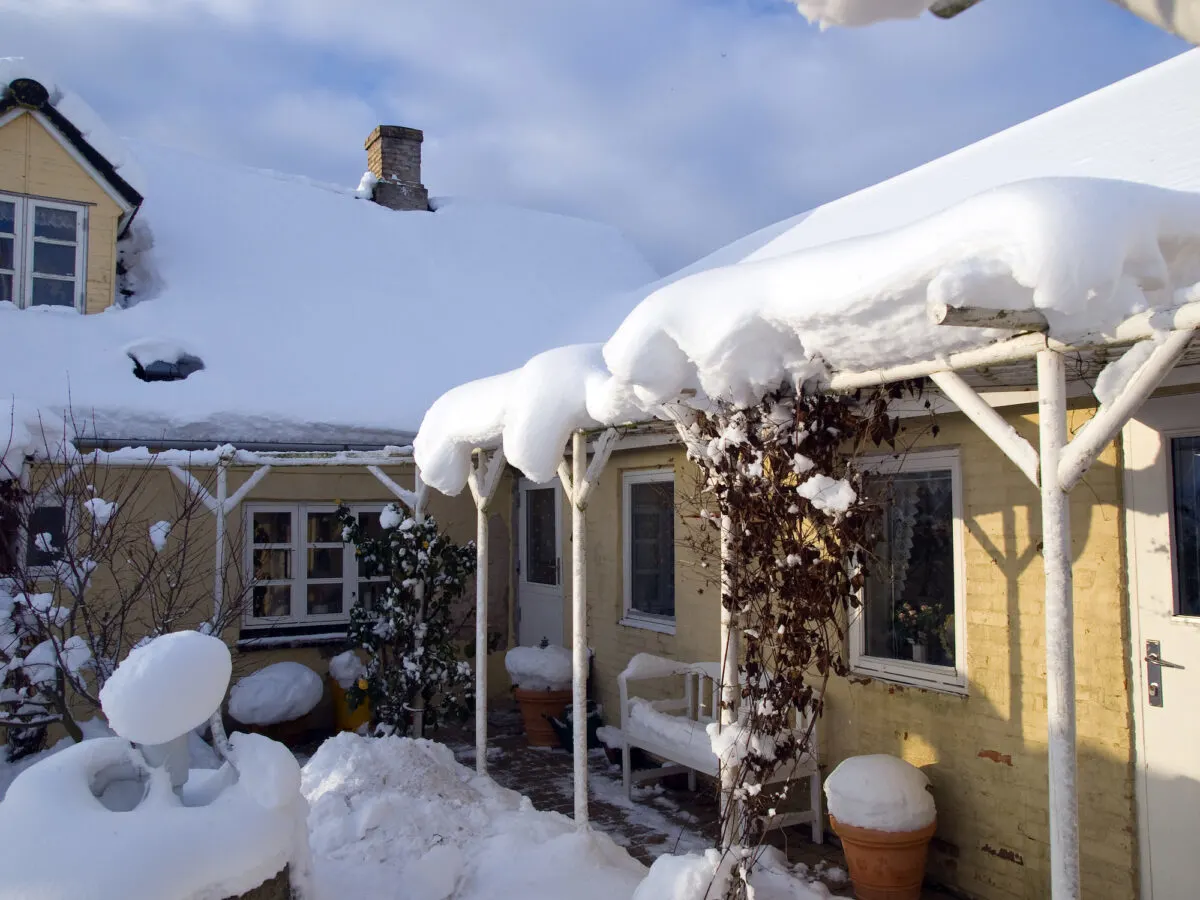As heavy snow piles up on your roof, you might worry about any damage it is causing. While removing snow from the ground can be relatively easy, removing snow from your roof can be tricky and dangerous if not done properly.
There are ways to remove snow from your roof without needing to climb on a ladder or climb on your roof. Those are the methods that I recommend in this guide.
Do not climb on your roof when it is icy, wet or snowy to clean it off. And do not use ladders to stand on while trying to use snow removal tools. Those are risky and dangerous methods. Hire a professional to do that method of snow removal.

When To Remove Snow From Your Roof
Every house is different, but as a general rule of thumb, it is recommended to remove snow from your roof if there are more than six inches. Over time, you will begin to know what is right for your house and where snow tends to build up the most.
The structure of your roof, along with its pitch, are the two most important factors in determining when to remove snow. Snow on a flat or shallow-pitched roof is likely to cause more damage than it would on a standard or high pitched roof.
A high pitched roof is able to use gravity for the snow to fall over time. However, flat and low pitched roofs will struggle to naturally remove the snow. Even if the snow melts, the water will remain. This can be even more dangerous in freezing conditions as it turns to ice and adding even more weight to your roof.
Another factor you should consider is the weight of the snow. Much like removing snow on the ground, moving light and fluffy snow is easier than moving heavy, wet snow. An icy, wet snow is heavier and, therefore, can damage your roof at a quicker rate than the light snow.
You can sometimes tell whether the excess weight of the snow is causing your roof to bow based on how difficult it is to open the windows and doors on the floor closest to your roof (i.e. in a two-story house, the second floor). If your windows or doors feel as though they are being pushed down then this is a clear sign that the roof is struggling and that snow should be removed as soon as possible.
Do you have an antenna on your roof? Here’s how to remove snow from a satellite dish.
Benefits Of Removing Snow From Your Roof
The majority of well-maintained roofs are built to withstand around 24 inches of snowfall. However, there are a number of varying factors that make this number difficult to follow. These include:
- Density of the snow
- Shape of your roof
- Roof’s general structural integrity.
If at any point you feel that the situation is unsafe, call a local professional who can remove the snow for you for a fee ($100 – $500 depending on the area and the size of the roof). Hiring out the job to a professional is a small expense considering the replacement of the roof alone. Ignoring the cleanup job of removing all the snow from inside your home and the major remodeling that goes with it could cost from $8,000 to $16,000.
Damage to your home can still be caused by too much snow on your roof even if the roof doesn’t cave in. This includes the warping of internal doors; warping and damage to the external window and door frames; and cracks in the drywall. All of these will cost time and thousands of dollars to fix.
Best Tools For Removing Snow From Your Roof
After years of experimenting with different tools and techniques, I have found the best way to remove snow from your roof is by using an extendable snow rake. This one has a 21-foot extension so that you can safely stand on the ground and remove snow from the roof.
Without a doubt, the best tool for removing snow from your roof is a long-handled snow rake. This snow rake has two poles that allow it to extend to a length of around 15 ft.
The MinnSnowta is described as a snow razer (it’s actually more like a snow roller) and extends to 24 ft. These snow rakes perform better with light / fluffy snow. However, they can work with wet / heavy snow in smaller capacities.
The greatest benefit of these rakes and rollers is that they do not require you to climb a ladder to your roof. In freezing and potentially icy conditions it is a terrible and dangerous idea to climb on your roof or on a ladder outdoors.
Tips For Removing Snow From Your Roof Safely
Here are a few hints and tips that I have found work best in ensuring you safely and effectively remove snow from your roof:
- Work from the roof overhands up towards the peak of the roof
- Do not attempt to clear more than 1 foot of snow with one sweep of a snow rake. The weight of the snow will make it hard to move and potentially damage your snow rake (and your back).
- Avoid using high powered machines to remove snow from your roof. These will just damage your roof.
- Do not build up a pile of snow on your roof to push off. Instead, work in strips pushing all the snow off in 1-foot increments. Creating a pile is likely to cause excess weight in one spot which could lead to a hole in the roof or the roof collapsing entirely.
- Look to see where the snow will fall onto the ground to make sure that you do not hit anyone or anything, such as a car or truck.
- Do not attempt to remove all the snow from your roof. Just focus on getting enough of the excess snow so that no damage is caused.
How To Remove Snow and Ice From Gutters
You may notice that snow and ice are causing your gutters to sag. If this is the case then the snow and ice need to be removed to prevent any further damage.
Ensuring your gutters are free from debris in the fall, such as leaves and twigs, can help to increase the flow of melting snow and ice. This will minimize the risk of your gutters becoming blocked and damaged as a result.
Gutters are essential in maintaining the integrity of your roof as well as minimizing the impact of water damage to your walls. If you find that your gutters are showing signs of wear from the snow or ice, then sprinkle some rock salt on the area. This will slowly melt the ice and allow it to drain naturally.
For a more immediate solution, spray the ice or snow with warm water. I have found that spraying the area using warm water rather than hot water works best. This helps to prevent the material of the gutter going into thermal shock or having to deal with a sudden surge in water as the snow melts.
How To Prevent Snow and Ice From Forming On a Roof and In Gutters
The best long term solution I have found for minimizing the build-up of snow and ice on your roof and in your gutters is the installation of heat cables.
These are not as expensive or as complicated as you may first think. My personal favorites are:
- Heat Tape Pro which are available in lengths of between 6ft and 150ft and comes with a 5-year warranty.
- Frost King which are available in lengths of between 30ft and 200ft.
The heat tape calculator will help you to determine the right length of cable for your home.
Heating cables help the slow naturally slide off your roof and help to prevent build up in your gutters. The majority use 5 watts per foot and therefore can add to the electric bill. I have found using them with a thermostatic plug helps minimize the electric use. The majority of cables are suitable for all roof materials but as always I would suggest checking the instructions and reviews before purchasing and installing.
There are also heated cables which are suitable for pipes. My personal favorite is Easy Heat as they come with a built-in thermostat allowing the cables to activate once a certain temperature has been reached.
Be sure to check out all of our helpful Emergency Preparedness articles for dealing with snow and ice.

